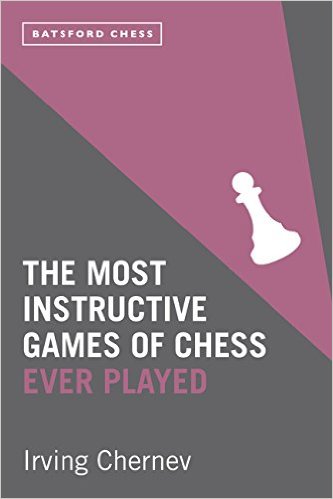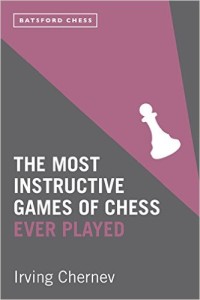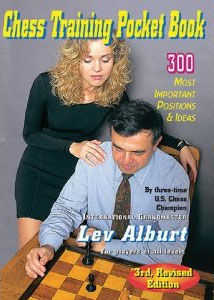The bestselling author of Logical Chess Move by Move guides players through 62 masterly strategies for chess success in The Most Instructive Games of Chess Ever Played.
One of the best ways to learn chess strategy is to play over annotated master games, and Logical Chess Move by Move is one of the best annotated game collections for beginners. This new revised edition by Batsford Chess is now in algebraic notation.
Irving Chernev shows beginners the chess strategies required to master the game through sixty two deeply annotated games.
Considered a classic of chess literature and a perfect companion to Chernev’s Logical Chess Move by Move (also recently updated).
Includes chess games from such chess greats as Capablanca, Tarrasch, Fischer, Alekhine, Lasker and Petrosian.
Table of Contents
1. Rook on the Seventh Rank
Capablanca – Tartakover, New York 1924
2. The King Is a Strong Piece
Tal – Lissitzin, Leningrad 1956
3. Knight Outpost at d5
Boleslavsky – Lissitzin, Moscow 1956
4. Aggressive Rook in the Ending
Tarrasch – Thorold, Manchester 1890
5. The Passed Pawn
Rubinstein – Duras, Vienna 1908
6. Weak Pawns, Weak Squares and Mighty, Mighty Knights
Mattison – Nimzovich, Carlsbad 1929
7. Finesse in the Ending
Domenech – Flohr, Rosas 1935
8. Phalanx of Pawns
Petrosian – Kozali, Montevideo 1954
9. Passed Pawn’s Lust to Expand
Fischer – Berliner, New York 1960
10. Rook and Pawn Ending
Smyslov – Reshevsky, Moscow 1948
11. King in the Center
Tartakover – Frentz, Paris 1933
12. The Shifting Attack
Reshevsky – Najdorf, Dallas 1957
13. Every Move a Threat!
Porges – Lasker, Nuremberg 1896
14. A Touch of Jujitsu
Petrosian – Korchnoi, Leningrad 1946
15. The King-Side Attack
Tarrasch – von Scheve, Leipzig 1894
16. Magnificent Outpost
Smyslov – Rudakovsky, Moscow 1945
17. The Art of Exchanging Pieces
Menchik – Capablanca, Hastings 1931
18. The Isolated Pawn
Lasker – Tarrasch, St. Petersburg 1914
19. The See-Saw Check, Zugzwang, and Other Tactical Tricks
Kupferstich – Andreassen, Denmark 1953
20. The Two Bishops
Rosenthal – Steinitz, Vienna 1873
21. Variety of Themes
Tartakover – Domenech, Sitges 1934
22. Systematic Strangulation
Tarrasch – Showalter, Vienna 1898
23. Good Bishop and Bad Bishop
Barden – Rossolimo, Hastings 1950
24. Coup de Grâce
Alekhine – Yates, London 1922
25. The Powerful Passed Pawns
Aganalian – Petrosian, Tiflis 1945
26. Bishop and a Half
Bondarevsky – Smyslov, Moscow 1946
27. Prophetic Strategy
Tarrasch, Schottlander, von Bardeleben, von Scheve – Mieses, Paulsen, Riemann, von Gottschall, Leipzig 1888
28. Problem-like Finale
Foltys – Golombek, London 1947
29. A Pawn Is a Pawn Is a Pawn
Kashdan – Steiner, Pasadena 1932
30. Board with Excitement
Keres – Tarnowski, Helsinki 1952
31. Elegant Simplification
Botvinnik – Boleslavsky, Moscow 1941
32. Four Endings in One
Blackburne – Weiss, New York 1889
33. Bishop and Pawn Ending Deluxe
Weiss – Blackburne, New York 1889
34. Brilliant Career of a Pawn
Panov – Taimanov, Moscow 1952
35. Dispatching the King’s Musketeers
Petrosian – Smyslov, Moscow 1961
36. The Sheltering Pawn
Schlage – Réti, Berlin 1928
37. The Power of Position Play
Capablanca – Germann, Miller, Skillicorn, London 1920
38. That Old Black Magic
Bernstein – Mieses, Coburg 1904
39. The Singular Strategy of Steinitz
Steinitz – Sellman, Baltimore 1885
40. The Odyssey of an Isolated Pawn
Burn – Znosko-Borovsky, Ostend 1906
41. Zugzwang, the Invincible Weapon
Marshall – Lasker, New York 1907
42. Symphony of Combinations
Eliskases – Grunfeld, Mahrisch-Ostrau 1933
43. Escorting the Potential Queen
Schlechter – Mason, Monte Carlo 1903
44. The Pillsbury Bind
Chekhover – Rudakovsky, Moscow 1945
45. The Galloping Knight
Tarrasch – Vogel, Nuremberg 1910
46. The Roving Rook
Pillsbury – Showalter, Brooklyn 1897
47. Web of Black Squares
Schlechter – John, Barmen 1905
48. Endgame Arithmetic
Mieses – Reshevsky, Margate 1935
49. In the Grand Manner
Janowsky – Capablanca, New York 1916
50. March of the Little Pawns
Pillsbury – Gunsberg, Hastings 1895
51. Irresistible Pawn-Roller
Marshall – Capablanca, New York 1909
52. Quiet, Like a Tiger
Botvinnik – Kann, Moscow 1931
53. Cornucopia of Ideas
Zagoryansky – Romanovsky, Moscow 1943
54. Endgame Duel – Knight against Rook
Botvinnik – Vidmar, Groningen 1946
55. Perennial Favorite
Bogolyubov – Réti, Mahrisch-Ostrau 1923
56. Command of the Board
Rubinstein – Schlechter, San Sebastian 1912
57. The King Takes a Walk
Botvinnik – Kann, Sverdlovsk 1943
58. Surprise! Surprise!
Petrosian – Pachman, Bled 1961
59. Bolt from the Blue
Andric – Daja, Belgrade 1949
60. Lured into Zugzwang
Marshall – Capablanca, New York 1918
61. The Flash of a Mighty Surprise
Olafsson – Fischer, Portoroz 1958
62. Symphony of Heavenly Length
Evans – Opsahl, Dubrovnik 1950
Index of Openings
Index of Players
Highly Recommended book for players with a 1400-1600 chess rating.


